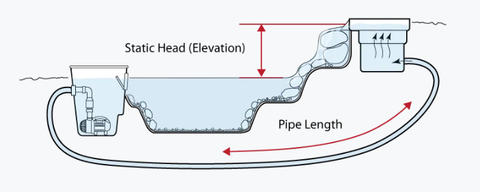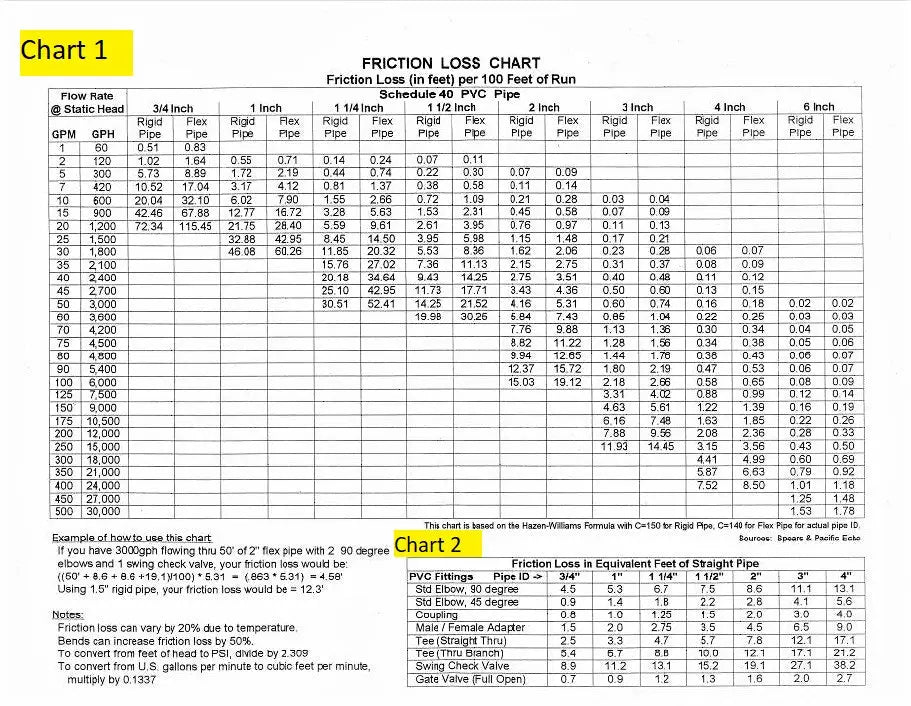Your pump is the heart of your pond, so investing some initial time upfront to assure you are getting the most efficient pump is well worth your time.
A quick rule of thumb is that your pump should turn over the volume of your pond at least once an hour. But we can finetune your pump selection with our Pond Pump Calculators below. Just follow the instructions below using the provided calculators to assist you. Please be aware that the calculators are sometimes slow to load because they are embedded from software outside of our website.
Step 1. Pond Volume
In other words, how many gallons of water are in your pond? Gallons are figured by multiplying the average length (ft) x average width (Ft) x average depth (ft) x 7.5. There are differing opinions pertaining to recirculation values, but a good rule of thumb is to recirculate the entire volume of water at least once an hour. Use this calculator to determine your pond volume. Enter your length, width, and average depth. The pond volume will be calculated at 80% of the total volume, which accounts for rocks in the pond. The calculator on the left is for rectangular ponds. Use the calculator on the right for round ponds.
Step 2. Waterfall Width
It is recommended between 100 - 200 gallons per hour (GPH) for every inch of waterfall width. On the lower flow rate (100 GPH) will give you a slower stream vs the higher flow rate (200 GPH) will give you a faster stream over your waterfall. Aquascape recommends 125 GPH for every inch of waterfall. Use this calculator to help you calculate your low and high flow rates.
Use Step 2 Calculator to figure this. Your Pump Size Flow Rate will be automatically calculated. Next, proceed to Step 3.

Step 3. Total Dynamic Head for Simple Ponds
If you have a simple pond, you can calculate your Total Dynamic Head. 
Static Head consists of:
Elevation (Static Head): Height difference from water level in the feature to the top of the waterfall.
Pipe Length: Total length of pipe (10 feet of pipe = 1 foot of head height)
Fittings Used (For simple ponds, this can be ignored): 90-degree fittings (equate to 2 feet of head height) and all other fittings (1 foot of head height) contribute to head losses.
Use the Step 3 Calculator for this.
For Rectangular Ponds For Circular Ponds
Step 4. Total Dynamic Head for Larger Applications
In most small ponds with short pipe runs friction loss is not typically a problem. Therefore, this step could most likely be skipped. However, in a pond with long streams or high flow rates, friction loss can have a big impact on the performance of the pump.
Use our calculator in Step 4 above to find your Total Dynamic Head. Friction Loss numbers are available on Chart 1 & Chart 2 below and are based on your diameter of pipe and whether it is flexible PVC or rigid PVC.
Here's an example on obtaining friction loss numbers: We are pumping 3446 GPH through 100' of 2" flex pipe. We are also using 1 - 2" 90-degree elbows.
Friction Loss for the 2" Flex Pipe: Using Chart 1, the pipe friction loss for the 2" pipe is 6.1 ft. Since the closest values are 3,000 GPH and 3600 GPH, we can interpolate to find that the friction loss is 6.1 ft.
Friction Loss for the 2" 90-Degree Elbows: Using Chart 2, the pipe friction loss for the 2" - 90-Degree Elbows is 8.6 for the elbow. Follow the "Std Elbow, 90 Degree" in the left column over to the "2" column.
These friction loss numbers shown in the above example can be added to the Total Dynamic Head Calculator in Step 4.

Step 5. Find Your Pump
Take your Recommended Flow Rate and Head Height information that was calculated for you (See example in Image 3 below).
Use these calculations to determine the "Best Operating Zone" on the Pump Flow Chart. Below is an example of a Pump Flow Chart.
As an example, if you're Recommended Flow Rate was 3,500 GPH with 28' of Total Head Height
,a great choice would be the 8-PN Pump because it is within the "Best Operating Zone"
shown in dark green with an "Application Head Height" in the range of 28'.
Image 3

Pump Flow Chart

Pump Performance Sheets
EasyPro - NOTE: Their specs are in GPM (gallons per minute)
